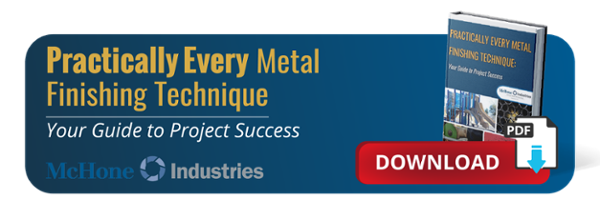You're racing to the end of your project, and it's down to the finish. But metal finishing can mean so many things. Various types of metal finishing are used to “treat” the exterior of your part by applying a layer to its surface, but which apply to your needs?
There are several types of finishing processes that serve a variety purposes. Below is a catalog of sorts for the major finishing methods, along with their purposes and benefits.
Why You Need Metal Finishing
“But I want my part quickly, and I want it cheap,” you say. Understandable, but skipping the finishing process can literally cost you in the long run, especially if your project is aesthetic in nature or will reside in a harsh environment.
Some of the reasons to (carefully) choose a finish are:
- Improved durability
- Better corrosion resistance
- A nicer-looking product
- Increased electrical conductivity
- Higher electrical resistance
- Higher tarnish resistance
- Potential for vulcanization
Types of Metal Finishing
Here they are, listed in alphabetical order. Note that there is no miracle finish that improves corrosion resistance AND improves looks AND upgrades wear resistance as well as the others. Certain processes have certain strengths.
Anodization
This option is aluminum-specific. And it forms all by itself.
Anodization happens when the naturally occurring oxide coating on the aluminum’s outer surface changes to a tightly adhering layer. This coating is much more resistant to corrosion and abrasion than what’s hidden inside, opening additional opportunities for use.
Note that anodizing coats very uniformly and therefore will not fill or smooth out a rough or damaged surface.
Blasting
Sand Blasting
-- This involves tumbling parts slowly to provide random exposure to a gun that’s blasting abrasive sand.
Bead Blasting
-- Bead blasting is the more environmentally friendly cousin of sand blasting. Most machines use glass beads and/or steel shot, which have slightly varying qualities.
These blasting processes remove light burrs and texturize the metal for an attractive finish.
Brushed Metal
Unlike plating (see below) and some other processes, this is is a great method for removing surface flaws.
An abrasive belt or wire brush creates a consistent, parallel grain surface to smooth out your part’s surface. Furthermore, the belt or brush can make slightly rounded edges perpendicular to the grain.
Buffing & Polishing
These processes involve the removal of metal to make a surface smoother. They’re ideal solutions for decorative products that benefit from luster and smoothness. Buffing and polishing are similar but not the same.
Polishing
-- This process generates a brushed or lined finish. A coarse line pattern remains afterward.
Buffing
-- This method removes the lines and creates a bright, lustrous finish. Another, less familiar use of buffing is to remove large amounts of metal.
Hot Blackening
As you may have guessed, this is a high-temperature process, and it’s black. Machines spread a thin layer of oxide onto your part’s surface to form a matte finish with high abrasion resistance.
Hot blackening is most commonly used in the production of firearms, auto parts, and tools.
Metal Grinding
Grinding machines use friction, attrition and/or compression to smooth out your part’s surface. Different machines deliver different levels of smoothness.
For example, rod mills are used to make metal rods, while semi-autogenous grinding (SAG) mills and autogenous grinding mills even out luxury metals like copper, gold, platinum, and silver.
Metal Plating
Electroplating
-- Also known as electrodeposition, this popular process involves depositing a thin layer of metal onto the surface of a component. The manufacturer uses an electrical current to force the desired reaction.
For many projects, the main goal of plating is to improve resistance to corrosion and wear. It’s also a cosmetic choice. (Ex.: A layer of gold is electrodeposited onto metal jewelry to improve its color and luster.) Several other benefits exist.
Electroless Plating
This process uses nonconductive layers, hence the name. It’s also fairly commonly used.
Immersion Plating
The goal here is to reduce the metal ion from solution via an atom exchange. This process is a bit less common.
Paint
Kind of the bare-bones option, paint is a nonmetallic coating used to increase surface protection at a low cost.
It’s wasteful and less environmentally friendly than other options like powder coating. Mostly, it exists to add color for cosmetic projects.
Passivation
This one is specific to stainless steel. The metal forms an inert, protective oxide film when exposed to oxygen in atmosphere.
While stainless steels are naturally corrosion-resistant, they are not entirely impervious to corrosion. Your manufacturer must remove contaminants down to the surface grain so they don’t inhibit the formation of this protective film.
Powder Coating
This nonmetallic coating is both environmental- and wallet-friendly. A well-versed vendor will make sure anything that falls off your components goes into a filtration system and back into the spray gun. This cuts down your material expenses.
Powder coating is also easier to automate, further ensuring spray and run efficiency.
Vibratory Finishing
This is a quick, en masse process used to deburr, burnish, clean, brighten, and otherwise tidy up relatively small workpieces. In this operation, your components are thrown in a tumbler with specially shaped pellets until they come out smooth.
Vibratory finishing systems usually produce a very flat finish because of how thorough the machines are. The tumbler will also cut inside a tube or cup-shaped piece, allowing the pellets to scrub those hard-to-reach places..
Similar methods include:
Centrifugal Barrel Finishing
This is ideal for small, high-precision parts.
Centrifugal Disc Finishing
If you insist on a short process cycle, try this.
Spindle Finishing
The media cost is low, but the labor cost is high.
Psst -- Here's a Shortcut
Knowing the basics of each finishing option is great, but it’s even more important to make sure the one you choose aligns with your project’s needs. The right fabricator can help you with that decision.
Want even more on the endless possibilities of metal finishing? We offer free design consultations and would be happy to give a more detailed explanation of these finishes.



